Greetings from the Veg IPM team! No major changes have taken place between last week and this week, and with the continuing rainy weather, scouting has been limited.
Sweet Corn
We’ve put out corn earworm pheromone traps throughout the state. While silking corn is the main target of CEW activity, we set the traps early to detect overwintering moths. We’ve seen quite a few already, showing that some CEW moths are definitely overwintering in both North and South New Jersey. So far, we haven’t spotted any serious corn pests through visual inspection.
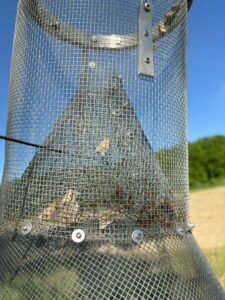
Corn earworm moths captured this week in Burlington County. Picture by Maria Cramer
Cole Crops
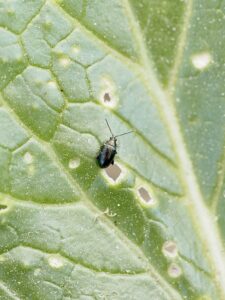
Flea beetle surrounded by feeding damage. Picture by Maria Cramer.
Flea beetle remain active in various cole crops. This year, they have been especially prevalent in lacinato kale, Napa cabbage and bok choy. Young plants are especially vulnerable to attack from flea beetles. The treatment threshold for flea beetles in heading cole crops is 50% infestation.
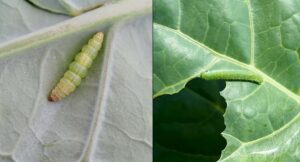
Left: Diamondback moth caterpillar, showing characteristic tapering at each end. Right: Imported cabbageworm caterpillar showing characteristic fuzziness. Pictures by Maria Cramer.
We’re seeing caterpillar activity (imported cabbageworm in the North and diamondback moth in the South) in cabbage and other cole crops. Treatment thresholds vary between crops and growth stage, but for heading cole crops between early vegetative and cupping, the treatment threshold is 30%. At this stage, sprayable Bt products (IRAC 11A) such as Dipel, Xentari, or Javelin can be effective on young imported cabbage worm caterpillars. Other materials approved for caterpillar control include Entrust/Radiant (IRAC 5), Proclaim (IRAC 6), Torac (IRAC 21A), and Exirel (IRAC 28). Diamondback moth has resistance to many insecticide groups, and pyrethroids (IRAC 3A) are not effective for their management. For Bt products and contact insecticides, coverage on the undersides the leaves is essential.
Tomatoes
In high tunnels and the first field plantings of tomatoes, we’re seeing limited aphid, thrips, and spider mite activity. If dealing with primarily aphids, products such as Beleaf (IRAC 29) are recommended, especially if plants have reached the flowering stage. We have seen aphid populations decline over the last couple of weeks without spray, probably due to lady beetle predation and parasitism from wasps. For thrips, Entrust, Radiant (IRAC 5) and Torac (IRAC 21A) can be used. For spider mites, Nealta (IRAC 25) is an effective material that is more friendly to beneficial insects, but Portal (IRAC 21A) and other materials can be used to manage populations. We’ve seen very few Colorado Potato Beetles, so while no controls are needed yet, we’ll keep an eye out for increasing populations.
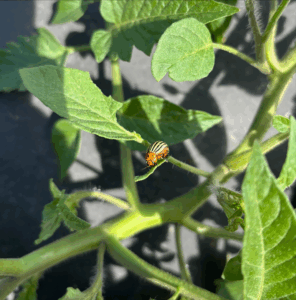
Colorado Potato Beetle adult
Beneficials
While scouting we’ve seen many beneficial insects, including predators like lacewings, lady beetles, and spined soldier bugs, as well as signs of parasitism, like aphid mummies. These natural enemies can help suppress certain pest populations. Lacewings, lady beetles, and soldier bugs feed on a wide range of soft-bodied pests, including aphids and caterpillars. Parasitoid wasps are more specialized, attacking one particular host. Basing sprays on treatment thresholds and using more selective insecticides helps preserve these natural enemies.
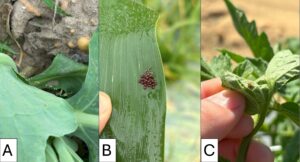
A) Green lacewing eggs on the underside of a cabbage leaf, B) Recently hatched spined soldier bug nymphs, and C) An aphid mummy. Pictures by Maria Cramer.
Please consult the Mid-Atlantic Commercial Vegetable Production Guide for a more comprehensive list of materials that are labeled for specific crops and pests. As always, be sure to follow label rates and application instructions.
Authors: Amanda Quadrel (Northern NJ Veg IPM coordinator) and Maria Cramer (Southern NJ Veg IPM coordinator)

